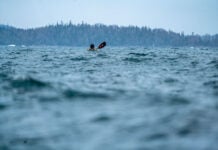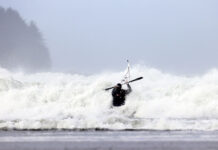No more outings for the outing club. This was the gist of the many newspaper headlines in April when Penn State University shared its controversial risk management review of its 79 student clubs.
While the university publicly acknowledged the many benefits students gain participating in outdoor activities like hiking, backpacking and paddling, it also stated the university would no longer allow the 98-year-old Outing Club to organize student-led, outdoor trips.
Campus Recreation at Penn State remains focused on providing as many opportunities in the outdoors as possible, while also keeping safety as a priority,” the statement read. The Outing Club, as well as Penn State’s caving and diving clubs, were deemed to have “an unacceptable level of risk in their current operation model.
It’s absurd for a school board to approve a year-end, capstone paddling trip for students with the caveat there is no swimming allowed, even if everyone wears a PFD
The university’s martial arts and rifle clubs were allowed to continue. The Penn State Outing Club decision received a lot of press, but it’s just one example in a trend sweeping across North America.
For more than a decade, there has been a noticeable erosion of the joy factor on guided youth paddling trips. The culprit is the risk management frenzy in our risk-averse society. These decisions are often made by school board officials with a fear of litigation and a general lack of familiarity with outdoor environments and activities.
Overbearing risk management plans are diluting the outdoor experience. And from recent stories of school- and camp-organized trips, it’s not surprising if a kid goes once and never wants to participate again.
It’s absurd for a school board to approve a year-end, capstone paddling trip for students with the caveat there is no swimming allowed, even if everyone wears a PFD.
Other programs mandate youth on trip are not allowed to handle knives—pocket knives and kitchen knives—or stoke the fire. If kids can’t swim, tend to the fire, whittle or help with dinner—what are they left doing? Probably wishing they had Snapchat.
There are many benefits to learning to manage risk. In healthy doses, outdoor risk builds confidence, independence, self-regulation and other life skills. Are the real risks students face every day on and off campus—driving to school, for example—smaller than those they would experience on an organized paddling trip? And are they providing comparable benefits? Certainly not.
If it was safety we were truly concerned about we would wear helmets not just in rapids but in the van ride on the highway to the trailhead. Data from one of the most comprehensive studies of whitewater rafting injuries in the United States from 2002 highlights whitewater rafting—considerably more risky than any flatwater trip—ranges from approximately 2.2 to 8.7 fatalities per million participant days, whereas driving motor vehicles results in approximately 152 fatalities per million participant days. Canoe and kayak tripping fatalities didn’t make the list.
Contextualizing risk is important. According to the National Safety Council in the United States, in 2009 there were 35,000 motor vehicle fatalities, of which approximately 2,000 were children under the age of 16. There were also 5,300 pedestrian fatalities, 8,600 fatalities from unintentional public falls, 4,500 fatalities from unintentional public food poisoning and 800 fatalities while bicycle riding.
We need to stand up for paddling and its minimal yet inherent risks
Those numbers might sound scary but remember the U.S. had 306.8 million citizens in 2009. Approximately 610,000 died of heart disease the same year. In the many real risks we encounter every day, outdoor recreation barely makes the list yet receives disproportionate outcry.
A 2014 report by the NCAA revealed nearly one in 10 of the United States’ 70,000 college football players reported suffering multiple concussions during their college career, which is linked to long-term brain damage, including higher rates of dementia. Why is an elevated risk of injury—especially traumatic brain injury—acceptable on a sports field? Colleges aren’t keeping stats on concussions in outdoor adventure because they’re so rare.
We need to stand up for paddling and its minimal yet inherent risks. These are inextricably linked to the joys and benefits of the activity itself. As paddlers, we need to help schools, camps and community groups move beyond a narrow safety-only focus.
If meeting safety standards is the sole mark of success for a paddling trip, the bar is set very low. Should safety be a given? Yes. All trips must be safe. Safety first, but not safety only. As safe as necessary, but not as safe as possible. Let’s then move onto higher aspirations, goals and motivations. Why not instead focus on instilling joy and a love of the activity and the landscape.
To complement and parallel the many outdoor adventure risk management conferences, we need joy management conferences. Time spent with other guides, teachers and club leaders discussing the merits of a particular campfire game, messy desserts and the best swimming holes. Time spent on ensuring the next generation learns to cherish wild places, instead of fear them.
On the slippery slope we’re descending, risk-averse decisions could become paddling-adverse programs. And this would be joyless for all.
Bob Henderson, Ph.D has taught outdoor education at university for more than 35 years. He is the author of Every Trail Has a Story: Heritage Travel in Canada and More Trails, More Tales. For more information visit www.bobhenderson.ca.
Ryan Howard, Ph.D. is the Director of Research, Risk and Innovation with ALIVE Outdoors. He is a designated Canadian Risk Manager and consults with government agencies, school boards and organizations on a variety of risk management issues and audits. Feature Photo: Mark Zelinski










Love this! General life is so much more dangerous than a canoe trip and the joys of canoeing certainly balance out the risks!
Go figure that institutions of higher learning can screw up risk management and turn it into risk aversion!
Outstanding article! As an outfitter I’m particularly disappointed in middle and high schools that refuse to expose kids to paddling and out life in general because of the “risks.” However, as a form teacher, I will also say that students are limited by the comfort level (or effort) by their teachers willingness to get kids outdoors. You bring up great points along with data…and NOTHING is 100% safe, to include your drive to the grocery store.
This is the generation of snowflake parents.
I saw this in the Army many years ago when cost and blaming leadership were the principle concern not proper risk management. I now fly helicopter air ambulances and talk risk tolerance, decision making and risk management as often as I can. I am also an avid kayak fisherman. One of the things I talk about is relationship between production and protection. One side is about completing the task and damn the risks. The other is about doing nothing is better than taking a risk. I also conducted some research into risk tolerance with helicopter pilots and one finding was that younger pilots tended to be more risk averse. This could be due to many things but one thought I have is that our younger people are being taught that risk is bad and should be avoided instead of teaching them to mitigate the risk and train them how to do that. Administrations that are more concerned with litigation and reputation make that impossible. Very sad.
This is awesome, spot on.
Finally some sense of mathematical reality to the risk management story.
We do Outdoor education because it’s AWESOME, and then we manage the risks accordingly, like we do everywhere else.
Keep spreading this message guys!
Great article, Bob. Sadly, it’s right on!
Risk management itself is not the problem. Bad risk management is.
As a former professional climbing guide, NOLS instructor, and Outward Bound instructor who has also taught in various public and private schools both in the classroom and the woods, I see a tremendous value in programs that get kids into the wilderness. But I am also a risk manager, and I chair a committee of outdoor program managers from over 30 schools in the Pacific Northwest that meets regularly to review various school programs, share best practices, and discuss common approaches to improve our risk management of wilderness programming.
Good risk management does not say that a particular activity is “too dangerous” or “unsafe” for students/clients/children to do. Good risk management instead looks at overall program goals, attempts to identify major risks, considers ways to manage these risks, informs participants of key risks (and things participants can do to help manage their risk), and, in the end, every institution has to make a decision of which risks it is willing to accept. I happen to work at a school with tremendous risk acceptance–I get to take students paddling in challenging waters, backpack hundreds of miles from towns and roads, and climb (and lead climb) in exciting areas, but my school’s risk tolerance is aided by the fact that we invest heavily in training for our faculty leaders, we evaluate their readiness to lead different types of courses (and course areas), and we have worked hard to “deforeignize” outdoor risk compared to some of the more commonly accepted risks like the author cites including athletic injuries.
But as a risk manager who works in schools, I am also aware that our industry is rife with accidents involving seriously unqualified adult leaders working for programs that ignore long-established best practices. I want my students, and my own children to learn in the woods, face discomfort, experience moments of failure, and face real consequences of decisions in the outdoors. But I also want to ensure their leaders are appropriately experienced leaders working with appropriate equipment and appropriate training. Risk management should help improve our programs, not end them.
I find it disturbing to have a country the accepts over 40,000 fatalities (up to a quarter are youth) and over 4.5 Million serious injuries on our roads. But a single incident in a youth program makes national news. I’ve been a water sports and climbing director since the mid 80s. And while we have had injuries on our trips, none have been serious. In fact a teen in our church youth group who was hurt using a saw on a canoe trip started bragging about having a badge of honor “scar” from the trip.
Life is not without risk, but I wish our system would balance risks in total and not just on lawyers pocketbook.
It’s not just kid’s programs. Kayak clubs, mostly populated by by grey haired people like me, are doing the same thing.